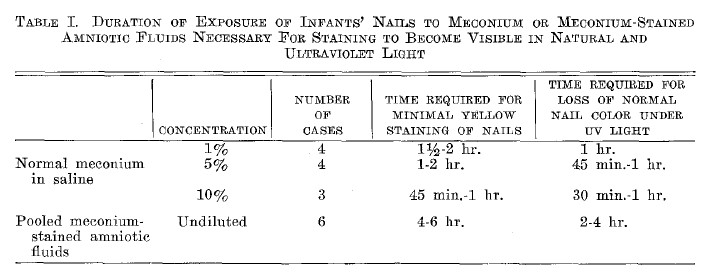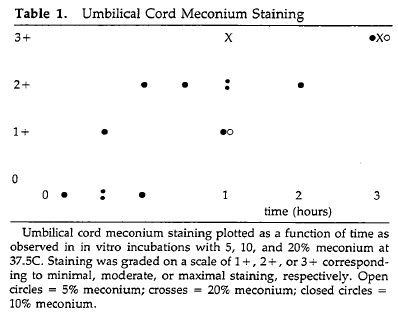This is one of the most difficult things to determine. Families being given a diagnosis of asphyxia in their baby often ask the question when did this happen? For sure this is not an exact science and in my opinion it is often difficult to answer the question with certainty. There are of course situations in which we can offer an educated guess such as if there is a witnessed acute cord compression such as with a cord presentation. In many other instances though it is more difficult to ascertain.
When meconium is passed in utero it is attributed to a hypoxic insult leading to internal anal sphincter relaxation. Depending on the length of exposure to this green amniotic fluid we also know that some babies may have a green or yellow hue to them from exposure of tissues to the pigments in meconium. What do we know about exposure of tissue to meconium? It turns out not too much but I will share with you a couple of interesting papers that help to give us a clue with a window into the past to provide a best estimate of how many hours have passed since a baby passed meconium. By knowing that we can then get a better guess as to when a hypoxic event may have happened.
Going way back in time
It was almost 70 years ago that Desmond MM et al published a paper trying to establish the answer to this question. The paper published in 1956 was called Meconium Staining of Newborn Infants. This paper out of Houston Texas did something that while on the surface seems disturbing was actually a creative way of determining how long exposure to meconium really takes. The authors took meconium stained fluid from 6 babies and put the fluid into sterile gloves. They then placed the feet of babies who had not been exposed to meconium into the meconium filled gloves to determine how long it took for nails to discolor and secondarily for vernix (the cheesy coating on the skin of newborns) to change color as well. The authors also created meconium slurries in normal saline of various percentages of 1 and 5% to get an idea in an artificial way with simulated meconium how long staining took. In order to determine timing of staining, at regular intervals the authors washed
the baby’s feet under running water, removed the moisture with with absorbent paper, and the nails were checked for yellow staining under natural light.

As you can see from Table 1 of the paper surprisingly for natural meconium stained amniotic fluid the time it takes to stain the nails of a baby yellow ranged from 4-6 hours. This occurred faster with meconium in normal saline but for run of the mill meconium you are looking at least 4-6 hours of exposure time.
Curiously for vernix in one case it took 10 hours to turn it yellow and 12 hours in another infant.
What About Umbilical Cords and Placenta
To answer this question we need to look at another study By Miller PW et al from 1985 entitled Dating the Time Interval From Meconium Passage to Birth. in this study meconium was collected from pregnancies experiencing passage before birth and similar to the 1950s study a slurry was created in normal saline. The placenta and umbilical cord were collected from pregnancies without meconium and exposed to the slurry while being incubated at 37 degrees Celsius.

The authors in this case demonstrated that over a period of 1-3 hours the tissues subjected to the meconium slurry became stained. One might come to the conclusion that this means at least 1-3 hours is needed to stain the tissues but in all likelihood it is probably longer. We know from the previous study that an artificial slurry in normal saline seems to stain faster than meconium in amniotic fluid so it would not surprise me if the authors were to have done the study using the meconium filled glove technique the tissues might need 4-6 hours as we saw in the last study. Regardless however the point is that it takes time.
What might this mean for timing a hypoxic episode
In the absence of any meconium staining it would suggest that a baby born with meconium likely had some distress that is less than 4 hours in duration. A baby who has a stained umbilical cord, yellow nails and discolored skin has likely been exposed to meconium for greater than 4 hours. To be sure this is not an exact science but let’s say there was a labor in which 8 hours prior to delivery there were some late decelerations and practitioners were questioning could there have been a significant hypoxic injury at that time. If the infant was born with meconium staining one might argue that indeed those decelerations may have contributed to the passage of meconium. If however a baby was born through meconium and there was no staining of the tissues it might lead one to conclude that if there were a significant hypoxic event it may have occurred after that time points since there should have been staining present.
I continue to say that in these cases one cannot determine exactly when a hypoxic event occurred most of the time but the degree of meconium staining and the information provided in this piece just might help give you some added information to try and make that educated guess a little more sophisticated.


Nice,interesting article
Thanks a lot
you are welcome